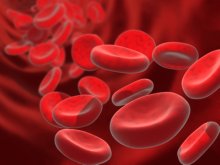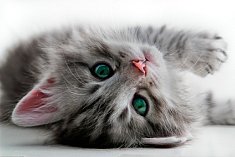|
Feline Anemia: Causes, Symptoms And Treatment Options

Feline Anemia is the reduction of red blood cells in your cat’s circulatory system. Red blood cells contain hemoglobin, which carries oxygen through both humans and cat's blood. Unfortunately, cats are prone to anemia due to the short life span of their red blood cells. Cat’s red blood cells have the shortest life span of many other mammal species. If your cat is not producing enough red blood cells or his/her body is destroying them, it can seriously affect the overall health of your cat. Below are the types, causes, symptoms, diagnosis and treatment of anemia in cats.
Types of Anemia
There are three different types of anemia: regenerative, non-regenerative and Hemotropic Mycoplasmosis. Regenerative anaemia refers to bone marrow producing new red blood cells in response to severe blood loss. Non-regenerative anemia refers to the lack of new red blood cell reproduction in the bone marrow, which is usually due to an underlying disease. Cats often have multiple causes for their anemia. For example, they may be suffering from two medical conditions at the same time. One condition can be causing regenerative anemia, but the other condition can be causing non-regenerative anemia. This can be tricky for veterinarians to diagnose and treat. Another type of feline anemia is Hemotropic Mycoplasmosis. This condition is actually caused by parasites, and cats are usually affected through tick, flea or mosquito bites. It is a serious infection that can easily be passed from cat to cat. Cats that spend a lot of time outdoors, especially during the spring and summer are at higher risk of developing this type of anemia.
Causes
Some causes of feline anemia includes feline kidney disease, congenital blood disorders, poor nutrition, lack of folic acid, lack of iron or other vitamins, bone marrow disorders, feline leukemia, feline immunodeficiency virus, some cancers or injury as a result of a serious accident, or tumors that cause internal bleeding.
Other serious conditions can also cause feline anemia such as haemorrhage and haemolysis. Haemorrhage can be caused by parasites such as fleas and lice, loss of blood due to a disease in the urinary tract or gastrointestinal tract. Haemolysis can be caused by infections such as FIP, feline leukaemia virus (FeLV) or feline haemoplasma infection. It’s also caused by low phosphate concentrations, tumors and drug side effects. Feline anemia can also be brought on by incompatible blood used during a blood transfusion. This can also occur when blood type A kittens are born to a mother with type B blood, and they ingest antibodies that are in their mother’s milk that destroys their red blood cells, which leads to anemia.
Symptoms
Typically, the primary symptom that is displayed when your cat is suffering from this condition is weakness and a pale whitish tongue and gums. Additional symptoms caused by feline anemia include weakness, fatigue, increased heart rate, increased respiratory rate, pica (the craving of unusual foods), feline weight loss, and jaundice. If another underlying disease is present, chronic renal failure and feline infectious peritonitis (FIP) may also present themselves. If your cat shows any of these signs, seek immediate medical help from your cat's veterinarian.
Finding the cause of your cat’s anemia is essential in proper diagnosis and treatment. Feline anemia can cause symptoms that range from mild to severe. The condition can also lead to death, especially if left untreated.
Diagnosis
Diagnosis of feline anaemia can be a complicated process since there are many causes for the condition including various diseases. Veterinarians perform a series of blood tests in order to diagnose feline anemia. Your vet will look for a reduction in red blood cell counts in your cat’s blood through a complete blood count sample, as well as reduced packed cell volume and reduced haemoglobin concentration. Examining blood smear will help determine whether the anemia is regenerative or not. More tests may be needed, such as a urine analysis and a blood chemistry panel, to rule out any diseases that may be causing the anemia such as feline immunodeficiency virus (FIV) and FeLV. Your vet may conduct other tests to rule out any other cat health problems based off of your cat’s medical history and any other symptoms your cat may be experiencing. A bone marrow biopsy may be done for cat’s with non regenerative anemia to detect the presence of antibodies that can bind to the surface of red blood cells. A biochemical profile may also be done to check your cat’s organs and to determine the overall health of your cat and
It is important to find the root cause of the anemia as this may greatly affect the type of treatment used.
Treatment
If the cause of your cat’s anemia is due to an infection, antibiotics may be administered. In some cases where there has been a significant loss of blood a blood transfusion may be required. Anti-parasitic medication for fleas and worms may be recommended if they were linked as the cause of the anemia. Changing your cat’s diet may be recommended and adding nutritional supplements such as iron in combination with other treatments. Veterinarians first treat the disease that is causing the anemia, and then continue to monitor your cat to see if there is any change or improvement. A combination of proper diagnosis and care will assist your cat in recovering from this illness.
It is important to seek professional medical care for your cat once you notice any of the above symptoms or a change in your cat’s behavior. Anemia is treatable and just requires proper diagnosis and proper care.
Similar Topics
Feline Lymphoma: Causes, Symptoms, Treatment - Discussing the cause, symptoms and treatment of feline lymphoma Feline Herpes Virus: Causes, Symptoms And Treatments - Learn about the different symptoms that your cat may display and the effective treatment options for feline herpes virus. Cat Flea Treatment- Cat fleas can be both irritating and annoying to your cat, here are some effective flea treatments to get rid of those pesky fleas. Feline Asthma: Causes, Symptoms And Treatment Options -Feline asthma is an allergic respiratory problem, the condition can range from mild to severe cases.
Feline Aids: Causes, Symptoms And Treatments -Feline aids, also known as feline immunodeficiency virus (FIV), affect 1.5 to 3 percent of healthy cats. Read to find out the causes, symptoms to be aware of and treatment options of this disease.
Return From Feline Anemia To Cat Health Home Page
|
Protect Your Pet Card
In Case Of An Emergency The Protect Your Pet Card Lets Emergency Services Know That You Have Pet/Pets Waiting For You At Home, Making Sure That Your Pets Are Cared For.
Get Your Card Today!
Win A Free $250 Petsmart Gift Card For Your Cat!
Must Be A US Resident
Click Here To Easily Enter For Your Chance To Win.

"There are few things in life more heartwarming than to be welcomed by a cat."






